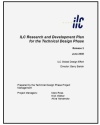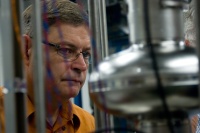Director’s Corner
19 June 2008
Hot off the press: Technical Design Phase ILC R&D plan
“The word draft has been removed!” announced Project Manager Nick Walker during the GDE meeting at Dubna, Russia. This seemingly innocent statement represents perhaps the most important accomplishment and milestone since completing the ILC Reference Design Report (RDR) last summer. The R&D plan outlines our strategy to advance the ILC design effort to the point where we will be ready to propose a robust construction project in a few years. It gives details on the R&D efforts, major goals, resources and schedules. This plan will be a “living document” that we intend to update periodically in order to make it an accurate reflection of our efforts as they develop.
Following the completion of the RDR, we began to detail our next steps in refining the ILC design towards a construction project. The first step in developing those plans was to reorganise ourselves around a more traditional project management structure. Our new project management then developed a preliminary set of work packages to organise the work. Just as all of this was falling into place and we had submitted a draft of the plan to the Funding Agencies for Large Colliders Resource Group (FALC RG), the roof caved in due to the funding pullbacks in both the UK and US.
Beginning in January 2008, we outlined our strategy for a re-plan that would take into account reduced resources by setting strict priorities, reduce duplication globally and make some stretch-outs. Since that time, we have been refining the new plan and reconciling it with the best understanding of the resources we can expect over the coming few years. That process was successfully brought to conclusion at Dubna with the official release of the plan. If we succeed at this plan, we will be ready to propose a construction project on a similar timescale as we expect science discoveries from LHC to come out, which we require to validate the science case for the ILC.
The Technical Design (TD) will be divided into two phases. We plan to complete the first phase in time for the International Conference on High Energy Physics in Paris (ICHEP 2010) during the summer of 2010. In the words of the report, the two phases will consist of the following:
- TD Phase 1 will conclude in mid-2010 with the publication of the TD Phase-1Interim Report. The emphasis of TD Phase 1 is on high-priority risk-mitigating R&D — most notably the Superconducting RF linac technology — and quantifying the scope for potential cost reduction of the current Reference Design. The end of TD Phase 1 will also see a re-baseline of the conceptual machine design, in preparation for more detailed technical design work in TD Phase 2. The re-baseline will take place after careful consideration and review of the results of the TD Phase 1 studies and the status of the critical R&D.
- TD Phase 2 (2010-2012) is intended to consolidate the new baseline reference design with more detailed technical design studies leading to an updated VALUE estimate and construction schedule. In parallel remaining critical R&D and technology demonstration milestones will be concluded. A further critical component of TD Phase 2 will be the detailed development of the Project Implementation Plan.
The report contains enough detail to serve internally as the central guide to our work, as well as being useful to the individual funding agencies to understand how their resources fit into the global picture. It will also be useful for review committees, who will be able to compare the goals we established with the progress we have made. The schedule presents the major goals for our R&D programme, establishes the priorities and flags other important deliverables that will be needed, including a Project Implementation Plan (PIP). We have not yet begun to organise the PIP and it will be a challenge, requiring resources not yet identified. Yet it will be essential to our presenting a technical design when we propose the project as well as having a realistic and flexible plan for how the project can be divided up, how it can be industrialised, and what the key features required of the governance for our global science effort are. I will write much more about the PIP in future columns as our ideas develop.
I end today’s column by especially commending our project managers for their diligence and systematic work to bring this plan together, especially Nick Walker for organising and driving the completion of the actual document. The combination of the RDR and the new R&D plan gives us a solid basis to focus our efforts as we continue to follow the path towards a real project.






















